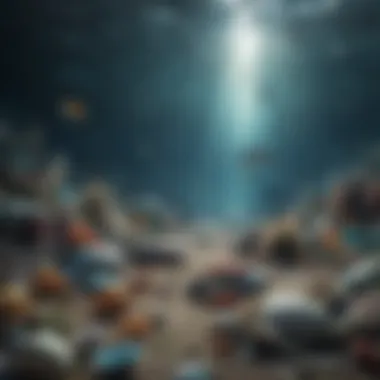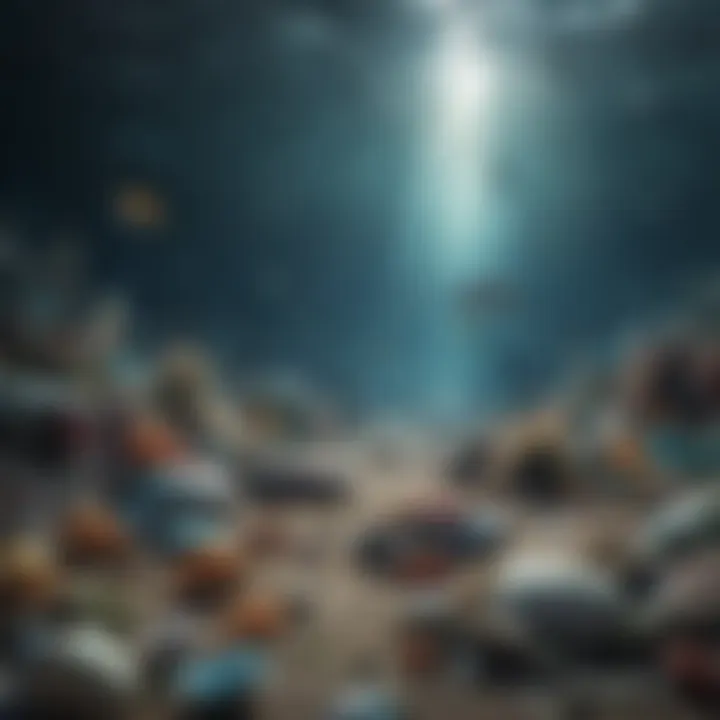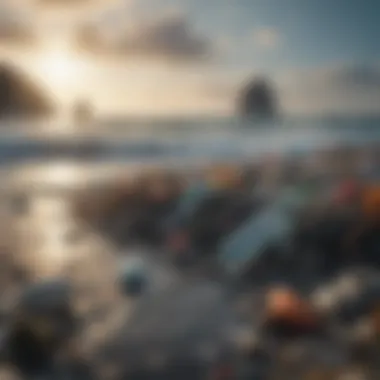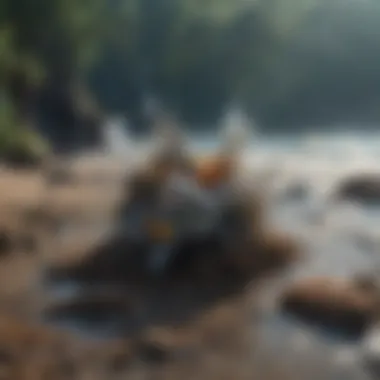The Impact of Plastic Pollution on Marine Ecosystems


Intro
Plastic pollution in our oceans presents a pressing global challenge. This issue encompasses a variety of materials, from microplastics to vast floating garbages. Over time, plastic debris deteriorates, breaking down into smaller particles while causing serious harm to marine environments and organisms.
The sheer scale of this problem demands attention. Reports indicate that millions of tons of plastic end up in oceans every year, leading to catastrophic effects on ecosystems, biodiversity, and ultimately human health. Critical discussions surround the need for effective strategies to combat this hazard, emphasizing urgency among policymakers, educators, and scientists.
This examination will uncover the multi-dimensional impacts of plastic pollution, its influences on marine life, the potential risks to human health, and the vital response measures necessary to confront this environmental crisis.
Preamble to Plastic Pollution
Plastic pollution has become a longstanding and pressing global issue. Its significance lies in the pervasive nature of plastics and their prolonged lifespan in the marine environment. Understanding plastic pollution is critical for various reasons. First, it helps to identify the sources and types of plastics entering the water and their potential impacts on ecosystems. Many communities rely on healthy oceans for their livelihoods, making awareness even more important.
Moreover, plastic pollution poses dire threats to marine life, creating a ripple effect that can impact human health and economies. By grasping the intricacies of this problem, efforts can be directed toward practical solutions and preventative measures.
Definition of Plastic Pollution
Plastic pollution refers to the accumulation of plastic products in the natural environment, particularly the oceans. This pollution comprises various types of plastic materials that originate from industrial, domestic, and agricultural sources. Plastics are typically non-biodegradable, which means they do not break down naturally over time. Instead, they fragment into smaller pieces, making them more challenging to manage and leading to microplastic particles that are often ingested by marine life.
In recognizing this definition, it becomes evident that action is necessary to address both the pollution and its sources. The challenge includes not only cleaning existing waste but also implementing systems that prevent further entry of plastics into marine environments.
Prevalence of Plastic in Oceans
The prevalence of plastic in oceans is alarmingly high. Estimates suggest that millions of tons of plastic enter the oceans each year, predominantly from land-based sources such as rivers and coastal activities. This influx has resulted in vast areas of plastic concentration, often referred to as gyres.
Research conducted by various oceanographic institutions quantifies the extent of this crisis. For instance, a study published in a scientific journal noted that there are approximately five trillion pieces of plastic floating in the global oceans.
Some critical points regarding the prevalence of plastic in oceans include:
- Types of plastics observed: These range from large items like fishing nets to tiny particles called microplastics.
- Geographical distribution: Plastic is found in all oceanic regions, from the shallow coastlines to the deep sea.
- Impacts on marine environments: The presence of plastic alters habitats and can lead to toxic contamination.
"Understanding the scale of plastic pollution is vital for creating effective policies and raising public awareness on marine conservation."
Types of Plastic Waste in the Ocean
Understanding the various types of plastic waste in the ocean is crucial for addressing the broader issue of plastic pollution. Plastics can be classified into different categories based on their size and source, which helps in identifying the challenges they pose to marine environments and ecosystems. Each type of plastic has distinct characteristics and impacts on marine life, making it essential to comprehend these differences when discussing mitigation strategies.
Microplastics
Microplastics are very small plastic particles, typically measuring less than five millimeters. They often originate from the breakdown of larger plastic items as well as from microbeads found in cosmetics and personal care products. The importance of studying microplastics lies in their pervasive presence in marine environments. Research shows that microplastics can be ingested by a wide variety of marine organisms, from plankton to fish and even larger species such as whales. This ingestion can lead to physical harm and can also result in the accumulation of toxic substances, which may disrupt biological processes. Furthermore, microplastics can serve as carriers for harmful chemicals and pollutants, exacerbating their impact on marine biodiversity.
Ingested microplastics can also affect the health of marine species. This ingestion can lead to a feeling of fullness, which might inhibit apt feeding behavior. The potential for entrapping harmful contaminants makes it imperative to understand microplastics and their long-reaching effects on ocean health.
Macroplastics
Macroplastics are larger plastic items, often exceeding five millimeters in size. They include everyday items such as bottles, bags, and fishing gear. The presence of macroplastics in marine environments poses significant risks. These larger plastics can cause entanglement, which leads to injury or death for many marine animals, including seals, turtles, and birds. Additionally, macroplastics can take hundreds of years to degrade, resulting in long-term accumulation within ecosystems.
The degradation process of macroplastics is complex and can generate microplastics, spreading their harmful effects further. Moreover, macroplastics contribute to the physical alteration of habitats, which can modify habitats that marine species rely on for breeding and survival. Understanding the role of macroplastics is vital for formulating effective cleanup and prevention strategies.
Industrial Plastics vs. Consumer Plastics
The distinction between industrial plastics and consumer plastics reveals important insights into their origins and impacts. Industrial plastics are produced primarily for manufacturing and commercial purposes. They often end up in the ocean through industrial accidents or improper disposal practices during transport. Examples include extruded plastic parts, packaging materials, and waste from factories. This type of plastic waste can be more challenging to manage due to its connection with industrial processes and regulations.
On the other hand, consumer plastics are everyday products such as food containers, bottles, and bags used by individuals. The management of consumer plastic pollution relies heavily on public awareness and policy measures aimed at reducing plastic consumption and encouraging recycling.
Understanding the differences between these two categories can enhance design efforts for reduction strategies. By targeting the specific routes through which these plastics enter marine environments, effective policies can be developed, benefitting both marine ecosystems and human health.
"The journey to mitigating plastic pollution starts with recognizing the nuanced types of waste we produce and their different impacts on our oceans."
Ecological Consequences
The ecological consequences of plastic pollution in the ocean are profound and multifaceted. Understanding this topic is crucial because it encapsulates how plastics disrupt not only marine ecosystems but also the intricate balance of life forms that depend on these environments. An effective exploration of ecological consequences reveals the significant interconnections that exist within the marine world and highlights the urgent need for action against plastic pollution.


Impact on Marine Biodiversity
Marine biodiversity is critically threatened by plastic pollution. Species across the food chain, from the smallest plankton to large marine mammals, are affected by the presence of plastics in their habitats. For instance, microplastics, which are tiny plastic particles measuring less than five millimeters, are ingested by marine organisms. This ingestion can result in physical harm and even death.
The bioaccumulation of toxins is another serious concern. When marine species consume microplastics, they also absorb harmful chemicals that plastics can leach into the environment. These toxins can accumulate in the tissues of marine organisms, compromising their health and potentially leading to reproductive issues, diminished growth, or increased mortality rates.
A broad range of marine animals, including fish, seabirds, and mammals, have been documented to suffer from these impacts. The reduction in populations of these species can have cascading effects on entire ecosystems. Additionally, when top predators are impacted, the overall biodiversity of marine ecosystems is threatened, leading to habitat degradation and loss of resilience.
Alteration of Marine Ecosystems
The presence of plastic pollution leads to significant alterations in marine ecosystems. Plastics can modify habitats, often serving as a substrate for the growth of algae and other organisms. Eco-sensitive areas such as coral reefs are particularly vulnerable. Coral reefs can experience reduced water quality due to trapped debris, which can hinder their health and growth.
Furthermore, plastic pollution can disrupt food webs. When larger marine species ingest plastics or become entangled, their roles within the food chain are compromised. The availability of prey species may also be affected, as populations decline due to increased mortality. Consequently, these changes can led to shifted community structures, impairing the dynamics of species interactions.
Ecological resilience is weakened when ecosystems are altered. Less diverse ecosystems tend to be more fragile and unable to recover from stressors. Therefore, it is crucial to acknowledge the invasive nature of plastics as they continue to permeate our oceans and threaten the delicate balance necessary for sustaining marine life.
"Plastic pollution not only affects individual marine species but sounds a pronounced alarm on the stability and integrity of entire ecosystems."
In summary, the ecological consequences of plastic pollution in the ocean present serious challenges to biodiversity and ecosystem functionality. Understanding and trying to mitigate these impacts is essential for the health of marine environments and the organisms that inhabit them.
Threats to Marine Life
The influence of plastic pollution on marine life is both profound and far-reaching. It underscores the urgent need to understand how these pollutants affect various oceanic species and ecosystems. Marine organisms are becoming increasingly vulnerable to the threats posed by plastic debris. This situation has broader implications for biodiversity and marine food webs. By examining specific threats to marine life, we gain insight into the severity of plastic pollution's impact on the environment.
Ingestion by Marine Species
One of the most immediate and concerning threats posed by plastic pollution is the ingestion of plastic materials by marine species. Many marine animals, including fish, seabirds, and marine mammals, often mistake plastic items for food. This is particularly true for smaller organisms, such as plankton, that may consume microplastics along with their normal diet.
Ingestion of plastics can lead to various health issues for marine animals. For example, they may experience internal injuries, blockages in the digestive tract, and malnutrition due to the reduced intake of actual nutrition. Moreover, the accumulation of plastic debris in the stomachs of these animals can confuse researchers when assessing their health and diets. Studies show that species vulnerable to plastic ingestion may struggle to survive, which could disrupt their populations.
Entanglement Risks
Entanglement in plastic waste presents a significant threat to marine life. Species such as seals, turtles, and birds can become ensnared in abandoned fishing gear, plastic ropes, and nets. Entanglement can cause severe injuries, impair mobility, and even lead to death. Animals may drown if they cannot surface to breathe.
Entangled animals also face challenges in finding food and escaping predators. Over time, as entanglement incidents continue, impacted populations might see their chances of recovery diminish. This risk is magnified for endangered species, whose numbers are already low. Efforts to reduce such threats must emphasize responsible waste disposal and encourage community engagement in cleanup initiatives.
Chemical Contamination from Plastics
Plastic pollution also threatens marine life through chemical contamination. Plastics can release hazardous chemicals into the water, which can be absorbed by marine organisms. Certain pollutants, like bisphenol A (BPA) and phthalates, have been shown to have detrimental effects on marine species. These chemicals can interfere with reproductive processes, growth, and overall health in marine organisms.
Furthermore, plastics may attract and absorb other harmful pollutants, such as heavy metals and pesticides, from surrounding waters. When marine animals consume these contaminated plastics, they risk bioaccumulation of dangerous substances. This bioaccumulation can ultimately impact not just individual species but entire marine ecosystems, creating a ripple effect throughout the food web.
"The complex web of life in the oceans is fundamentally altered when plastics enter the environment, leading to unforeseen implications for both wildlife and human health."
Understanding the threats from plastic pollution to marine life is crucial in developing effective mitigation strategies. It highlights the need for sustained research, public education, and international cooperation to address this escalating crisis.
Implications for Food Chains
Understanding the implications of plastic pollution on food chains is crucial because it reveals the interconnected nature of ocean ecosystems and their impact on human health. Plastic waste, particularly in the form of microplastics, infiltrates marine environments, affecting species at various trophic levels. The disturbance in food chains can lead to alterations in species populations, impacting not just marine life but also human communities that rely on these ecosystems for sustenance.
Bioaccumulation of Toxins
Bioaccumulation refers to the process through which organisms absorb harmful substances, such as plastics, faster than they can eliminate them. When marine species ingest microplastics, they also ingest other toxic chemicals that adhere to the plastic, like pesticides and heavy metals. Fish, shellfish, and other marine organisms accumulate these toxins in their bodies. Over time, these toxins can reach harmful levels, posing significant risks not only to marine species but also to predators higher up the food chain, including humans.
The ingestion of contaminated organisms can lead to serious health issues for humans, including hormonal disruption and neurological effects. The occurrence of toxins in seafood is particularly alarming as seafood consumption is common among various populations worldwide, illustrating the need for careful monitoring and regulation of plastic waste in oceans.
"The scale and scope of plastic pollution in our oceans necessitate immediate attention to protect marine life and human health alike."
Effects on Fisheries and Aquaculture
The repercussions of plastic pollution extend to fisheries and aquaculture, two critical components of the global food system. As fish and shellfish ingest plastics and the associated toxins, their health deteriorates, leading to lower fish populations and affected yields. This decline poses economic risks for those reliant on fishing for their livelihood.
In aquaculture, the presence of plastics can adversely affect the growth rates and health of farmed species, thus compromising food security. The potential contamination of farmed fish with microplastics also raises concerns for consumers, as market preferences increasingly trend towards health and environmental sustainability.


Key Points on Fisheries and Aquaculture:
- Diminished Fish Populations: Reduces availability for commercial fisheries, impacting local economies.
- Economic Impact: Increased costs in monitoring and mitigating plastic contamination.
- Consumer Perception: Growing awareness about plastic contamination may deter consumers from purchasing affected seafood products.
The continued presence of plastic in marine environments poses an array of challenges that require immediate action to sustain healthy ecosystems and ensure food security for communities depending on marine resources.
Human Health Concerns
Plastic pollution poses significant risks to human health, stemming from the contamination of seafood and the presence of microplastics. These issues are critical topics in the discussion of oceanic plastic pollution. Understanding how plastic impacts food sources and human exposure is essential. It highlights the need for awareness and preventive measures.
Contamination of Seafood
As plastics break down in ocean ecosystems, they release harmful chemicals into marine life. Fish and shellfish ingest microplastics, leading to bioaccumulation of toxins. When humans consume seafood, these toxins can enter our systems. There are documented cases of heavy metals and other harmful substances found in commercially viable fish species. This contamination poses not only individual health risks but also public health concerns on a larger scale. The presence of persistent organic pollutants in these organisms raises alarms among scientists and health officials. People who consume seafood regularly may be unknowingly exposed to these dangerous compounds.
"The continuous chain of plastic contamination in marine ecosystems directly impacts human health through seafood consumption."
It is vital for consumers to be aware of the source of their seafood. Regulations on fishing practices and monitoring chemical levels are necessary to ensure safer consumption. Local communities that depend on fish as a primary food source are particularly vulnerable to this contamination. They must be informed so they can make safer dietary choices.
Potential Risks from Microplastics
Microplastics are small plastic particles, often less than five millimeters in size, that result from the breakdown of larger plastic items or are intentionally manufactured for various applications. These particles are now ubiquitous in our oceans and can easily enter the food chain. Humans can ingest microplastics not only through seafood but also through drinking water and even air. The health impacts of microplastic ingestion are still under study, but early findings suggest that they may lead to various health complications.
Recent research indicates that microplastics could cause inflammation or even have toxic effects on human cells. This raises significant concerns about long-term exposure and the cumulative effects of microplastics in the human body. Furthermore, the ability of microplastics to absorb and carry other environmental contaminants amplifies the risks, as they can transport harmful substances into human systems.
Socioeconomic Impacts
The relationship between plastic pollution and socioeconomic factors is intricate and significant. The consequences of plastic waste extend beyond environmental degradation, affecting communities, economies, and public health. This section aims to illustrate how plastic pollution can disrupt livelihoods and impose fiscal burdens on society, thus emphasizing the need for appropriate interventions.
Impact on Coastal Communities
Coastal communities are often the first to experience the negative effects of plastic pollution. Many of these communities rely on marine resources for their economic sustenance. Fisheries flourish near clean oceans, and tourism thrives on picturesque beaches. However, as plastic pollution escalates, fish populations decline due to the ingestion of plastics. This directly affects the local fishery industry, reducing the income of those who depend on it. Jobs are also at risk as tourists might avoid polluted beaches, leading to diminished revenues for local businesses.
A study noted that regions with visible plastic waste saw a drop in tourist numbers. In turn, this impacts restaurants, hotels, and retail shops. As businesses suffer, local economies contract, and residents face increasing unemployment. Furthermore, the social fabric of coastal communities can deteriorate when economic opportunities diminish, leading to increased poverty and reduced investment in education and healthcare.
Economic Costs of Cleanup and Mitigation
Addressing plastic pollution comes with significant economic implications. Cleanup operations require funding, labor, and resources, often diverting money from other vital community projects. Municipalities find themselves allocating substantial portions of their budgets to remove plastics from beaches and waterways. Estimates indicate that coastal regions worldwide spend billions on cleanup efforts annually.
In addition to direct cleanup costs, there are indirect expenses related to loss of income and productivity. For instance, when fishing stocks decrease or tourism wanes, businesses incur losses and individuals face financial strain.
A proactive approach focusing on pollution prevention can, in the long run, alleviate these costs. Investing in waste management technologies or community awareness can yield significant savings. Promoting recycling and responsible disposal can also minimize the negative repercussions associated with plastic waste.
"The economic burden from plastic pollution could cost the global economy up to $139 billion per year by 2025 if immediate actions are not taken."
In summary, the socioeconomic impacts of plastic pollution in oceans are profound. Coastal communities face economic hardship, and cleanup efforts require substantial investment, thus highlighting the complex interplay between environmental health and economic stability. Recognizing these issues is essential for developing effective solutions to mitigate plastic pollution.
Legislation and Policy Approaches
The issue of plastic pollution in the ocean has garnered global attention, necessitating a robust legislative framework to mitigate its impact. Effective legislation and policies are crucial for addressing the growing crisis. Without stringent laws and regulations, plastic waste continues to increase, exacerbating environmental degradation. Here we explore current environmental regulations and global initiatives that aim to tackle this crisis and emphasize their importance.
Current Environmental Regulations
Many countries are implementing environmental regulations aimed at reducing plastic waste. For instance, the European Union has enacted regulatory measures such as the Single-Use Plastics Directive. This directive targets specific plastic items most commonly found in marine litter, including plastic cutlery, plates, and straws. Countries in the EU have committed to limiting these items to reduce their environmental footprint.
In the United States, various states have introduced legislation to ban or tax single-use plastics. California's law prohibiting plastic bags is one notable example. Such local regulations contribute to a broader national movement focused on reducing plastic dependency.
Current regulations face challenges. Compliance monitoring is often lacking, and enforcement can be inconsistent. However, the presence of these laws is still significant. They not only aim to reduce plastic pollution but also create awareness among communities about responsible waste management practices.
Global Agreements and Initiatives
International cooperation is key to combating plastic pollution. One of the most significant agreements is the Basel Convention, which addresses the transboundary movement of hazardous waste, including plastics. Although originally focused on hazardous waste, its extension to plastic waste indicates a progressive shift in global governance.


Additionally, the Global Plastics Action Partnership, launched by the World Economic Forum, is another vital initiative fostering collaboration between governments, businesses, and civil societies. This partnership aims to unite efforts across nations, establishing a shared vision to tackle plastic pollution.
The United Nations has also become active in promoting sustainable practices through the 2030 Agenda for Sustainable Development, particularly Goal 12 which focuses on responsible consumption.
These global agreements provide a framework for countries to develop and implement national strategies addressing plastic pollution. They also encourage countries to share best practices and progress toward their commitments in reducing plastic waste.
"Legislation and policy approaches are essential in shaping frameworks that encourage sustainable practices and foster individual responsibility in waste management."
Public Awareness and Education
Public awareness and education play a crucial role in addressing the plastic pollution crisis in our oceans. Awareness about how plastic waste affects marine ecosystems, biodiversity, and human health is critical. Many people are unaware that the daily choices they make significantly contribute to this escalating issue.
Role of Community Initiatives
Community initiatives are essential in fostering a culture of responsibility and sustainability. When local groups come together to combat plastic pollution, they can create a significant impact. These initiatives often involve clean-up drives, recycling programs, and educational workshops.
- Clean-up drives help to physically reduce waste in local waterways.
- Recycling programs encourage responsible disposal practices.
- Workshops educate participants on the importance of reducing single-use plastics.
Such community efforts raise awareness and create a collective sense of urgency. They empower individuals to take part in the solution. When communities engage actively, they also develop a network of advocates who can influence local policies.
"Every action counts. When communities unite, they can challenge the status quo on plastic waste management."
Educational Programs and Outreach
Educational programs tailored to diverse audiences, from students to professionals, are vital for instilling a sense of responsibility toward plastic use. Schools can incorporate modules on plastic pollution into their curriculum to create environmental awareness from a young age. Educational programs can include:
- Workshops that provide practical knowledge about reducing plastic waste.
- Field trips to marine environments, allowing students to observe the effects of pollution firsthand.
- Online resources to provide wider reach and accessibility.
Collaborating with universities and research institutions can further enhance the education drive by integrating scientific findings into community workshops and material. Outreach campaigns via social media and traditional media can spread the message widely, engaging a broader audience and encouraging action.
Innovative Solutions and Alternatives
Addressing the issue of plastic pollution in the ocean involves exploring innovative solutions and alternatives. Such approaches are crucial because they can mitigate the adverse impacts while also offering sustainable practices that can be adopted globally. These solutions not only need to tackle existing pollution but also prevent further contamination of marine environments.
Development of Biodegradable Plastics
Biodegradable plastics present a viable alternative to traditional plastics. Unlike conventional plastics, which may take hundreds of years to break down, biodegradable options can decompose more rapidly under certain conditions. This characteristic reduces the risks associated with marine debris significantly. In recent years, several companies have focused on developing new biodegradable materials. For example, polylactic acid, made from renewable resources like corn starch, has gained attention due to its reduced environmental impact.
However, the production of biodegradable plastics must be handled cautiously. Potential drawbacks include land use for raw materials and the energy costs associated with manufacturing.
Also, not all biodegradable plastics degrade properly in marine environments; therefore, it is essential to establish specific standards and certification for their effective use in ocean applications. Without that, there is a risk that they will still contribute to pollution.
Technological Innovations in Waste Management
Technology plays a critical role in reducing plastic waste in oceans. Innovations in waste management are essential for recycling and recovering materials, thus preventing them from entering the water bodies. For instance, methods such as advanced sorting technologies and automated recycling systems have shown promise in enhancing recycling efficiency. They allow for better separation of plastic types, which facilitates higher quality recycling streams.
In addition, the use of AI-based monitoring systems can help identify sources and hotspots of plastic waste. These systems can analyze data to optimize cleanup efforts and target polluted areas more effectively. Moreover, technologies like ocean clean-up drones are emerging, which aim to collect plastic debris before it disperses further into marine ecosystems.
The integration of these technological solutions can significantly impact the overall effectiveness of waste management systems and ultimately lead to a cleaner ocean.
End and Future Directions
In concluding the discussion surrounding plastic pollution in the ocean, it becomes evident that this issue transcends mere environmental concern. The implications of plastic pollution are extensive, affecting marine ecosystems, human health, and socioeconomic factors. This examination has synthesized various elements surrounding the topic, emphasizing not just the immediate impacts, but also the long-term ramifications for future generations.
Research indicates that efforts to combat plastic pollution must be multilayered. One must consider the effectiveness of existing policies and the necessity for enhanced public awareness. Future directions should also emphasize innovative technologies for waste management and the importance of community engagement to foster change.
"Addressing plastic pollution requires a collective effort across nations, policy-makers, and individuals to ensure a cleaner, healthier ocean for all."
Summary of Key Findings
The key findings regarding plastic pollution in the ocean reveal several critical points:
- Prevalence of Plastic: Millions of tons of plastic enter the oceans annually, leading to serious environmental issues.
- Impact on Marine Life: Marine species face threats from ingestion and entanglement, disrupting biodiversity and ecosystem stability.
- Human Health Risks: The contamination of seafood with microplastics poses potential health risks to humans.
- Economics of Pollution: The cost of cleanup and its implications for coastal economies highlight the need for preventive measures.
- Legislative Gaps: Existing environmental regulations are often inadequate in addressing the complexities of plastic pollution, spurring the need for stronger global agreements.
Importance of Continued Research
Continued research in this area is paramount. Understanding the degradation processes of plastics in marine settings is essential for developing effective mitigation strategies. Moreover, research in alternative materials such as biodegradable plastics must progress to offer viable solutions. The intersection of ecological health and socioeconomic factors necessitates further investigation into how communities can adapt and respond to the impacts of plastic pollution. Engaging in interdisciplinary studies can foster a more comprehensive approach, ensuring that both human and environmental health are prioritized as we push toward sustainable practices.
In summary, the dire state of our oceans demands ongoing commitment and research. Only through informed actions can we hope to reduce plastic pollution and safeguard marine and human health alike.















